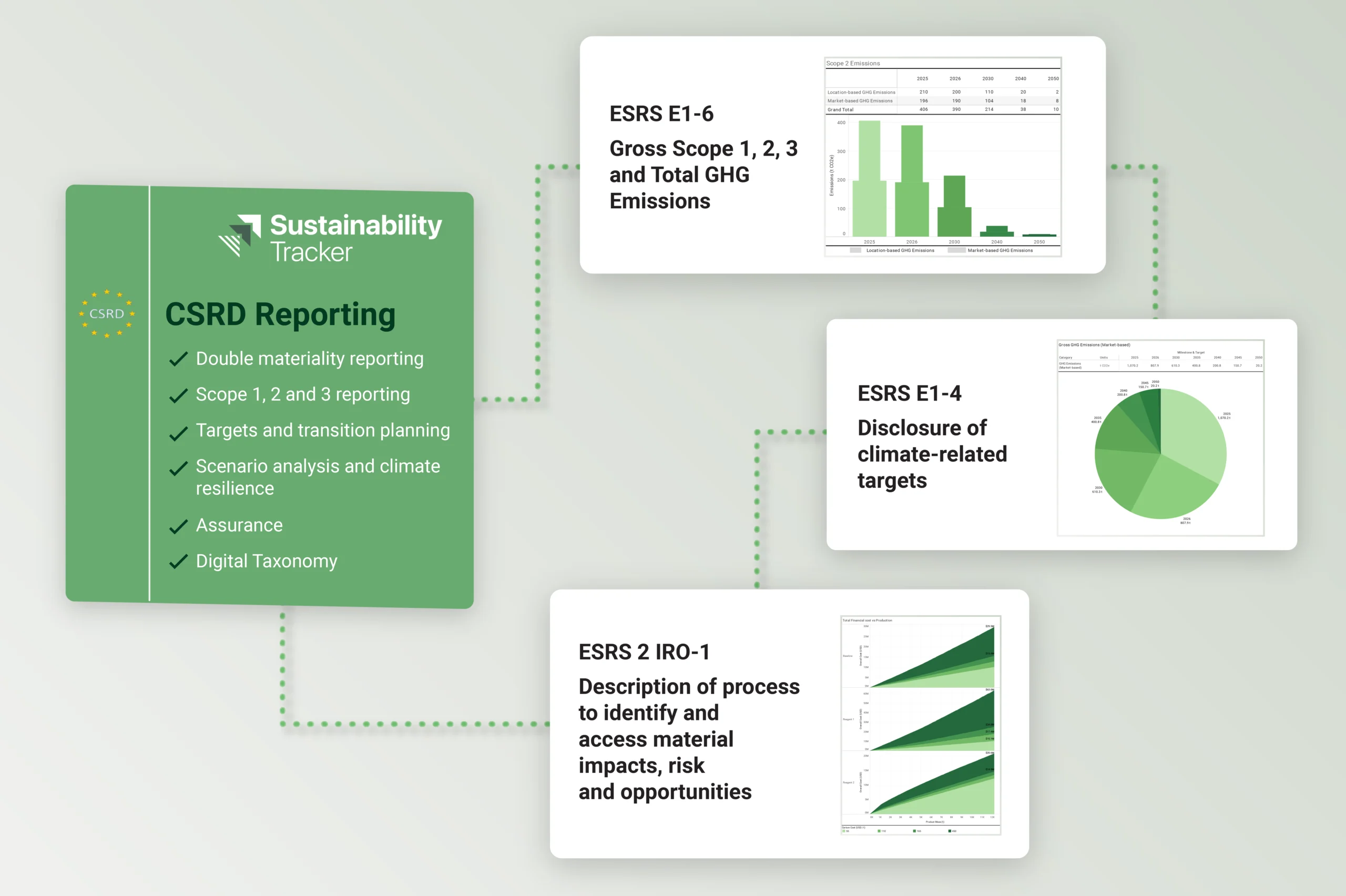
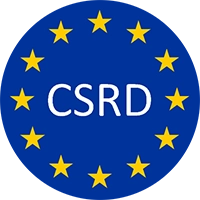
Industrial CSRD Reporting Software
How to meet your CSRD reporting obligations with real-world data
What is the Corporate Sustainability Reporting Directive (CSRD)?
The CSRD requires companies to report on their sustainability information to provide investors and stakeholders with information to assess investment risks related to climate change and other sustainability factors and report on the company’s impact on people and the environment.
Organisations must disclose the impacts, risks, and opportunities (IRO) deemed material under these standards from the company and stakeholder perspectives.
The CSRD was adopted by the European Parliament and the European Council in November 2022 and entered into force on 5 January 2023. As of 1 January 2024, at least 50,000 companies operating in the EU must comply with the new CSRD rules and publish sustainability disclosures in their 2024/2025 financial reports.
The CSRD includes two cross-cutting standards and ten topic standards of the European Sustainability Reporting Standards (ESRS), including climate change, pollution and other aspects of corporate sustainability.
As reported by the European Council, sector-specific standards will become effective on 30 June 2026. This allows companies more time to focus on implementing the first set of ESRS.
Specific sectors will likely be oil and gas, coal, quarries and mining, road transport, agriculture, farming and fisheries, motor vehicles, energy production and utilities, food and beverages, textiles, accessories, footwear and jewellery.
Double materiality assessment is crucial for CSRD compliance. This means companies need to report on both the impact of the organisation’s activities on society and the environment (impact materiality) and the effects of the environmental, social and governance (ESG) factors on the financial position of the company (financial materiality).
Organisations must start preparing their data and systems to meet their reporting and complaint obligations.
Your digital roadmap to CSRD compliance
Whether you are just starting your sustainability journey or already have sustainability reporting and compliance processes and targets in place, digital CSRD reporting software can help at every stage.
Starting by centralising your data, the right digital tools are the only way to address today’s mandatory requirements, adapt to evolving legislative frameworks, and help set and achieve decarbonisation targets.
For complex industrial organisations, ISS recommends a staged roadmap to CSRD digital reporting that starts with meeting mandatory compliance rules and moves towards advanced ESG capabilities and emissions reduction strategies as your capabilities mature.
There are four critical steps in the recommended roadmap that align with our Sustainability Tracker (ST) packages:
Centralise data
Deploy CSRD reporting software to centralise data and use templates to meet today’s compliance regulations.
Set up the systems needed for centralised records that capture the in-depth CSRD data points needed to adjust to evolving CSRD reporting requirements.
Automate data capture
On top of centralised data, the next step is to add automated data capture and data quality to your CSRD reporting.
This includes data cleansing, organisation and validation tools (using machine learning), and advanced visualisation tools to deliver dynamic, accurate and auditable near real-time CSRD reporting.
Finance-grade reporting
Beyond automation, the next step is enabling finance-grade sustainability reporting and automated validation of CSRD data against industrial operations data using a mass and energy balance configured to your site/s.
You can report according to the CSRD reporting boundaries, time horizons (short, medium and long term) and extract machine-readable format to deliver the required CSRD electronic formats.
Decarbonisation roadmap
The final step is adding the granular analysis needed to plan, execute and evaluate your decarbonisation roadmap and adapt to evolving CSRD and sector-specific standards.
Running a steady-state simulation of your asset, validated finance-grade industrial data is used to enable complex forecasting, transition planning, scenario analysis and climate resilience assessments.
You can then adjust inputs and compare final production, emissions and consumption using advanced visualisation tools.
What is the CSRD reporting format?
The CSRD reporting format is based on the European Sustainability Reporting Standards (ESRS), which provide a framework for companies to report on their sustainability performance consistently and comparably. The first set of ESRS was published on 22 December 2023.
These standards apply to companies under the scope of CSRD regardless of the sector in which they operate.
There are three categories of ESRS reporting:
1. Cross-cutting standards (mandatory)
These standards, including ESRS 1 and ESRS 2, set the foundation for sustainability reporting requirements. They are mandatory and apply to all companies reporting under CSRD.
ESRS 1: General requirement
ESRS 2: General disclosures
2. Topical standards (if material)
These standards provide specific reporting requirements for a range of environmental, social and governance (ESG) topics, including climate change, human rights and biodiversity. They are designed to help companies report on their impact and performance in specific areas and are only reported if they are assessed as material.
If a company deems topic standard ESRS E1 immaterial in the CSRD reporting scope, and omits the disclosure requirements, the report must include a detailed explanation of the materiality assessment’s conclusions. This includes a forward-looking analysis of the conditions that could lead the company to conclude that this topic standard ESRS E1 is material in the future.
Other topic standards deemed immaterial do not require a detailed explanation. However, the company may mention the negative materiality assessment under standards ESRS 2 IRO-2, General disclosures.
Environment
E1 – Climate change
E2 – Pollution
E3 – Water & marine resources
E4 – Biodiversity & ecosystems
E5 – Resource use and circular economy
Social
S1 – Own workforce
S2 – Workers in own value chain
S3 – Affected communities
S4 – Consumers & end-users
Governance
G1 – Business conduct
3. Sector-specific reporting standards (not yet released)
While details are not yet released, these standards will provide additional guidance for companies in specific industries, such as finance or manufacturing, to report on sector-specific sustainability issues and impacts. These will help companies address industry-specific risks and opportunities.
The ESRS standards include over 1,200 data points
Each ESRS Disclosure Requirement requires one or more specific data points to be reported. This includes all the data points from ESRS 2 and the topical standards. There are no specific data point disclosure requirements for ESRS 1 General Requirements.
EFRAG released the draft list of ESRS data points in December 2023. This presents the complete list of the detailed requirements contained in each Disclosure Requirement and related Application Requirements. The list organises and categorises narrative and quantitative disclosures, making it a valuable resource for adapting to a new reporting standard or forming the basis of a data gap analysis.
General
ESRS 2 General disclosures
16 Disclosure requirements
195 Data points
Governance
ESRS G1 Business conduct
7 Disclosure requirements
53 Data points
Social
ESRS S1
Own workforce
18 Disclosure requirements
202 Data points
ESRS S2
Workers in the value chain
6 Disclosure requirements
72 Data points
ESRS S3
Affected communities
6 Disclosure requirements
71 Data points
ESRS S4
Consumers and end-users
6 Disclosure requirements
70 Data points
Environment
ESRS E2
Climate change
12 Disclosure requirements
220 Data points
ESRS E2
Pollution
7 Disclosure requirements
68 Data points
ESRS E3
Water and marine resources
6 Disclosure requirements
48 Data points
ESRS E4
Biodiversity and ecosystems
8 Disclosure requirements
120 Data points
ESRS E5
Resource use and circular economy
7 Disclosure requirements
84 Data points
Why digital reporting is the only solution for CSRD reporting
The need for regular reporting in a machine-readable digital taxonomy across hundreds of specific data points and the increasing requirement for detailed scenario analysis and forward-looking statements means that data-driven technology is the only solution to meet CSRD’s evolving sustainability disclosure rules and reporting standards.
Manual spreadsheets cannot capture or process the volumes of data needed to deliver immutable, unalterable and auditable sustainability reports.
Make the most of your data using digital tools to achieve decarbonisation goals and accurate reporting. ST’s granular data will be mapped to the data points to be reported per the ESRS.
The good news is that digital tools that have been proven to solve these data challenges for complex industrial organisations are available.
These examples demonstrate how Sustainability Tracker (ST) CSRD reporting software can satisfy CSRD compliance and help achieve decarbonisation goals with granular reports that map directly to the data points required by the ESRS.
Double Materiality Reporting
CSRD requires companies to measure sustainability data points to evaluate impact and financial materiality in one platform with historical comparisons.
In this example we demonstrate how ST reports on financial resources allocated as well as the impact measurement of water consumption.
Financial Materiality:
Example data points to be reported as per ESRS E3-2. Disclosure of water and marine resources-related actions and resources allocated to their implementation.
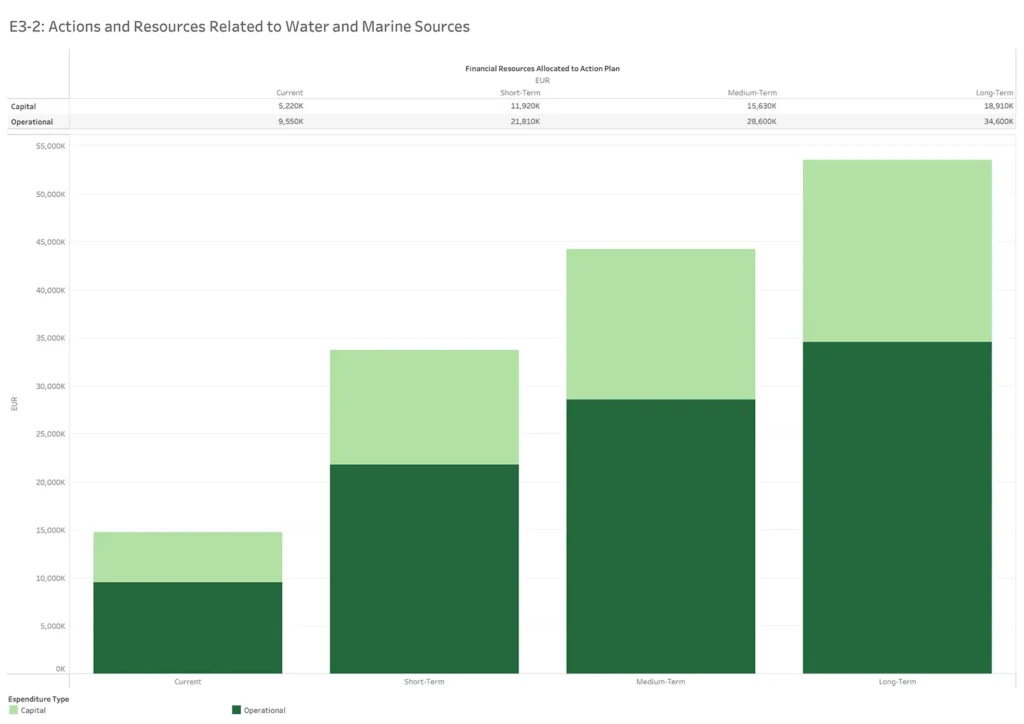
Impact Materiality:
Example data points to be reported as per ESRS E3-4. Disclosure of information about water consumption performance related to material impacts, risks and opportunities.
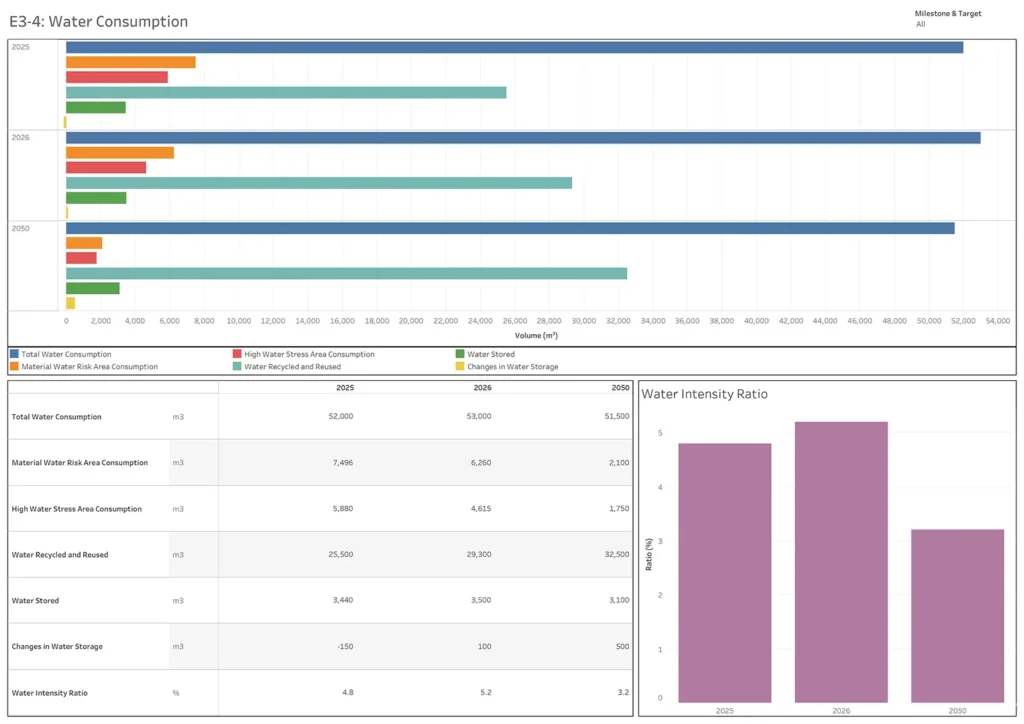
Scopes 1, 2 and 3 Reporting
Sustainability Tracker can accurately measure Scopes 1, 2 and 3 across your value chain and adjust organisational boundaries as per the CSRD reporting requirements.
Scope 3 reporting is mandatory and can be broken down into categories.
Gross Scope 1,2,3 and Total GHG Emissions Report:
Example of data points to be reported as per the ESRS E1-6. Disclosure of GHG emissions.

Targets & Transition Planning
CSRD requires disclosure of transition plans compatibility with the most recent international agreement on climate change.
This includes disclosure on GHG emissions reduction targets in five-year rolling periods, including targets set for 2030 and 2050 if available.
Targets Related to Climate Change Mitigation and Adaptation:
Here is an example of the milestone data points that need to be reported as per the CSRD ESRS E1-4 that ST can automate. Disclosure of climate-related targets.
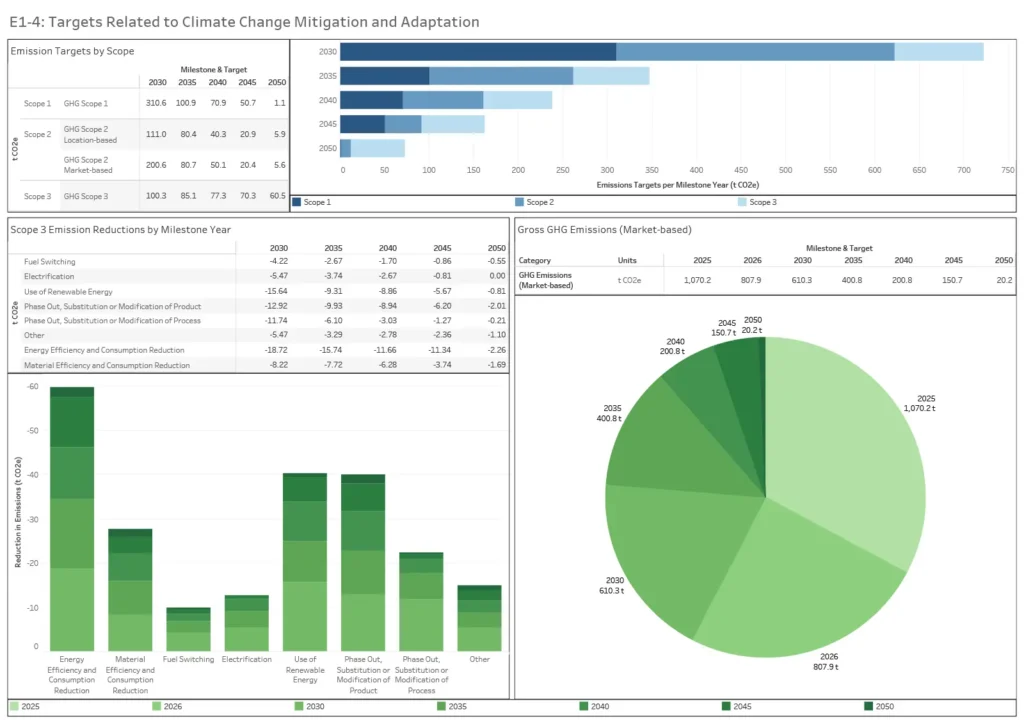
Scenario analysis
CSRD requires companies to conduct scenario analysis to evaluate their climate resilience and explain how their strategies align with the Paris Agreement’s goals.
Climate resilience refers to a company’s ability to adapt to climate change and its related challenges and opportunities.
This includes managing risks, responding to changes, and taking advantage of new opportunities, both strategically and operationally.
Quantitative Climate Scenario Analysis
Here is an example of the use of quantitative climate scenario analysis as referenced in the Disclosure Requirement related to ESRS 2 IRO-1.Total emissions from using different reagents has been calculated compared to a set baseline, including the associated cost to the organisation.

Assurance
CSRD requires organisations to track sustainability metrics back to source data such as instrumentation data and follow an audit trail to the reported values.
Assurance Report:
This is an example of the audit trail in the activity feed that details any changes or modifications to data.
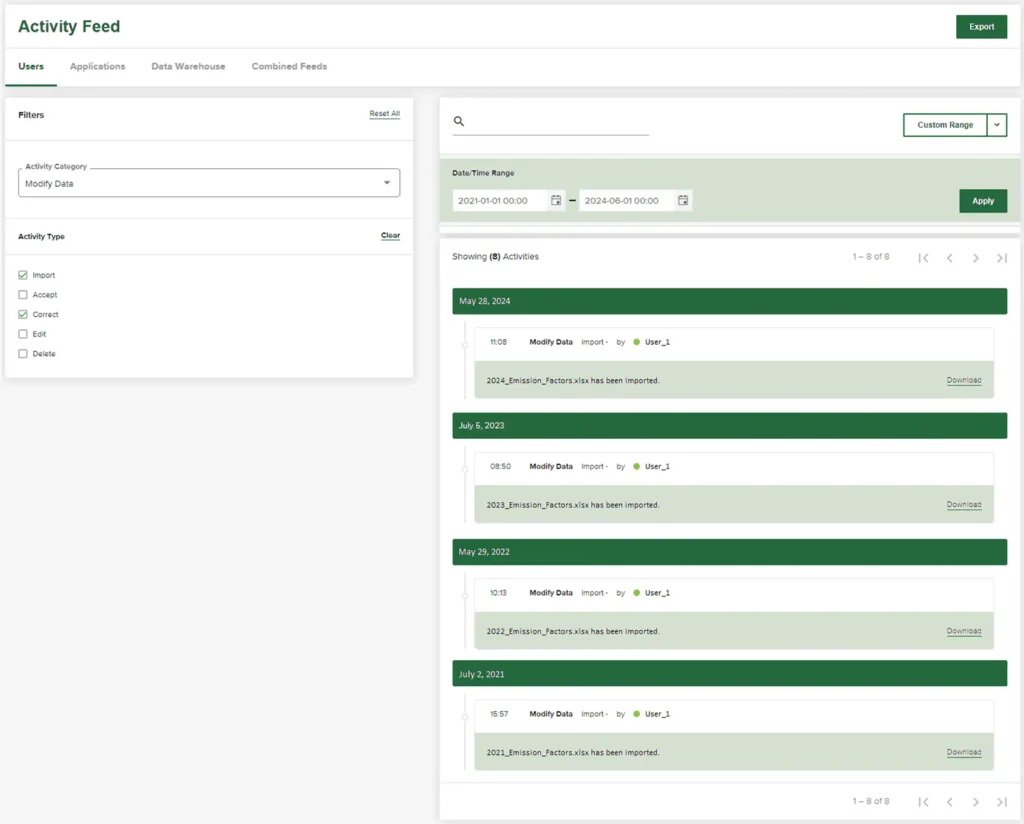
Digital Taxonomy
CSRD requires management reports to be submitted in accordance with the CSRD electronic reporting format.
CSRD Electronic Reporting format:
European Financial Reporting Advisory Group (EFRAG) has developed a digital XBRL taxonomy. ST can map source data to digital tags as per the taxonomy.

CSRD Frequently Asked Questions
What is the Corporate Sustainability Reporting Directive (CSRD)?
Put simply, the CSRD, or Corporate Sustainability Reporting Directive, is a European Union regulation that mandates sustainability reporting for a broader range of companies. It aims to improve transparency and accountability on environmental, social and governance (ESG) issues.
When does the CSRD come into effect?
The CSRD was adopted in November 2022 and took effect on 5 January 2023. Starting 1 January 2024, at least 50,000 EU-based companies must follow the new CSRD rules and include sustainability information in their 2024/2025 financial reports.
Who does the CSRD apply to?
The provisions of the CSRD are broad in scope and apply to many companies operating in the EU, estimated to be nearly 50,000 in total. They will increasingly apply to a significant number of SMEs (small and medium-sized enterprises).
What needs to be reported under the CSRD?
Companies must report on a comprehensive range of ESG factors using the European Sustainability Reporting Standards (ESRS). This includes environmental impacts like climate change and pollution, social aspects like labour practices and diversity, and governance issues like business ethics and anti-corruption measures.
What is double materiality, and how does it impact reporting?
The CSRD emphasises the concept of double materiality. Companies need to report on sustainability factors that are both material to their business (financial impact) and those that significantly impact people and the environment (external impact).
What are the benefits of complying with the CSRD?
Compliance with the CSRD offers several benefits, including:
- Increased transparency and investor confidence
- Improved risk management and identification of opportunities
- Enhanced stakeholder engagement and brand reputation
- Access to sustainable finance options
What are the risks of not complying with the CSRD?
Companies that aren’t ready to meet their CSRD compliance regulations may face risks such as:
- Legal and regulatory risks, including fines and penalties
- Reputation and brand damage, leading to loss of stakeholder trust
- Financial risks, including increased costs and loss of investments
- Loss of business opportunities and competitive disadvantage
- Legal action by stakeholders, including investors
Why Excel is no longer compatible with sustainability reporting
Many industrial plants continue to use Excel spreadsheets to perform sustainability reporting. However, given the complexity of data, multiple data points and the requirement that reports need to be provided in an auditable electronic reporting format to be compliant, it’s become clear that Excel can no longer keep pace. Error-prone and time-consuming, using Excel exposes risks. Without the right data-driven sustainability platform, it’s impossible to meet CSRD reporting requirements, let alone implement effective decarbonisation strategies.
How does Sustainability Tracker (ST) help with CSRD reporting?
Sustainability Tracker simplifies CSRD reporting with a user-friendly interface, providing a comprehensive framework that covers all necessary disclosures. It automates data collection and calculation to reduce manual effort to produce reports in the required CSRD digital format. ST also enables companies to set targets, track progress and benchmark performance.
The Sustainability Tracker difference
Designed to navigate multiple global frameworks and many separate ESG performance indicators, Sustainability Tracker is a uniquely flexible and comprehensive sustainability reporting solution for today and the future.
Whether you are just starting your sustainability journey or already have sustainability reporting and compliance processes and targets in place, ST has a flexible package for every stage.
The below benefits span from ticking sustainability compliance boxes on our Standard Package right through to advanced environmental, social and governance (ESG) capabilities on our Expert and Enterprise Packages:
- Track end-to-end sustainability indicators spanning Scopes 1, 2 & 3, and Climate & Nature
- Single source of centralised, validated, organised and integrated sustainability data
- Accurate asset-wide mass and energy balance customised to your exact process as a digital replica of your operations
- Contextualise your measured activity data using source data as inputs
- Analyse, track and report activity data right down to a product level
- Track and consolidate on-site and off-site renewable energy sources
- Capture and report on data directly related to the industrial asset it has been implemented in, including integration with third-party data
- Track, simulate, test, analyse and forecast scenarios
- Future-proof technology delivered in a scalable cloud-based SaaS platform
Take control of your CSRD sustainability reporting
More sustainability reporting resources
About the Authors
This article has been collaboratively authored by the Industrial Sustainability Solutions team and fact-checked and authorised by Managing Director and industry specialist John Vagenas.


